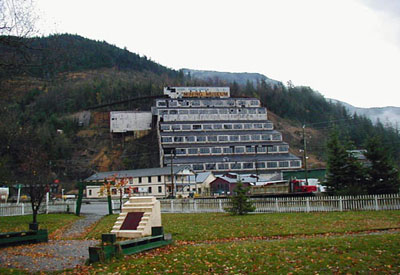Britannia Mines Concentrator National Historic Site of Canada
Britannia Beach, British Columbia

General view
© Parks Canada Agency / Agence Parcs Canada, 2002.
Address :
Highway 99, Britannia Beach, British Columbia
Recognition Statute:
Historic Sites and Monuments Act (R.S.C., 1985, c. H-4)
Designation Date:
1987-11-20
Dates:
-
1922 to 1923
(Construction)
-
1903 to 1974
(Significant)
Event, Person, Organization:
-
Britannia Mines
(Organization)
Other Name(s):
-
Britannia Mines Concentrator
(Designation Name)
Research Report Number:
1987-040, 2002-SDC/CDE-008
Plaque(s)
Existing plaque: Howe Sound Highway 99, Squamish-Lillooet D, British Columbia
For almost 70 years the Britannia mines were an important producer of copper ore and during the 1920s and 1930s they constituted one of the largest mining operations in Canada. Britannia began producing ore in 1905 but did not become a significant operation until after 1912 when a second concentrator was built. The present gravity-fed concentrator, completed in 1923, was highly innovative, as, for example, in the use of bulk flotation. By 1912 both mill and mine towns had been established to house men and families of a permanent racially-mixed work force that numbered over 1,000 in 1929. The mines closed in 1974.
Description of Historic Place
Britannia Mines Concentrator is a gravity-fed concentrator used to process copper ore for one of Canada's largest mining operations in the 1920s and 1930s. It is the centrepiece of a complex of buildings associated with mining and shipping ore, a monolithic structure that rises in successive stages up the rock face of Mount Sheer at the edge of Howe Sound, 28 miles (45 kilometres) north of Vancouver.
Now owned by the Britannia Beach Historical Society, it forms part of the British Columbia Museum of Mining.
Heritage Value
Britannia Mines Concentrator was designated a national historic site in 1987 because the Britannia Mines were an important source of copper ore for almost 70 years and during the 1920s and 1930s it constituted one of the largest mining operations in Canada, the present gravity-fed concentrator was highly innovative, as, for example, in the use of bulk flotation.
The heritage value of Britannia Mines Concentrator National Historic Site lies in its physical illustration of the innovative technology that made Britannia Mines an important copper mining site in Canadian history. Britannia Mines Concentrator was built in 1922-1923 by Britannia Mines, which had been extracting copper ore in the area around Mount Sheer on the eastern shore of Howe Sound since 1903. This replaced earlier gravity concentrators installed on the site in 1904 and 1914. This steel and concrete structure incorporated new milling and processing techniques. Designed to process 2,500 tons of ore per day, it made Britannia the largest producer of copper ore concentrate in the British Empire between 1925 and 1930. The concentrator continued to operate until Britannia Mines closed in 1974.
Sources: Historic Sites and Monuments Board of Canada, Minutes, November 1987; Commemorative Integrity Statement, November 2003.
Character-Defining Elements
Key elements contributing to the heritage value of this site include: its geographic location, at the edge of the mountains, close to an ocean harbour; its concrete and steel construction technology; the distinctive height, consolidated massing and stepped profile with its modern industrial definition as a series of eight horizontal bands characterized by large square windows set in parallel placement and irregular placement of windows on its side elevations; its industrial forms and materials, including concrete platforms, steel trusses, wood and corrugated iron siding, corrugated iron roofing, and prefabricated multi-paned double hung glass windows; the visibility of functional additions on the building's exterior (such as a ventilator shed, trestle and skipway); the functional layout of the interior, and particularly the definition and respective locations of special-purpose areas (including the presence of tanks, specialty and multi-level platforms, safety steps and railings); remnant machinery inside the building, particularly that associated with the innovative gravity-fed concentrating process and bulk flotation it employed;
- the visual relationship of the concentrator to the larger industrial setting defined by the 25 structures associated with mill and mine operations including tanks, workshops, sheds, bunkhouses, houses, office buildings, shipping facilities; the visual relationship between the concentrator and the former dock area located on the other side of the highway overlooking Howe Sound.